Physical Address
304 North Cardinal St.
Dorchester Center, MA 02124
Physical Address
304 North Cardinal St.
Dorchester Center, MA 02124
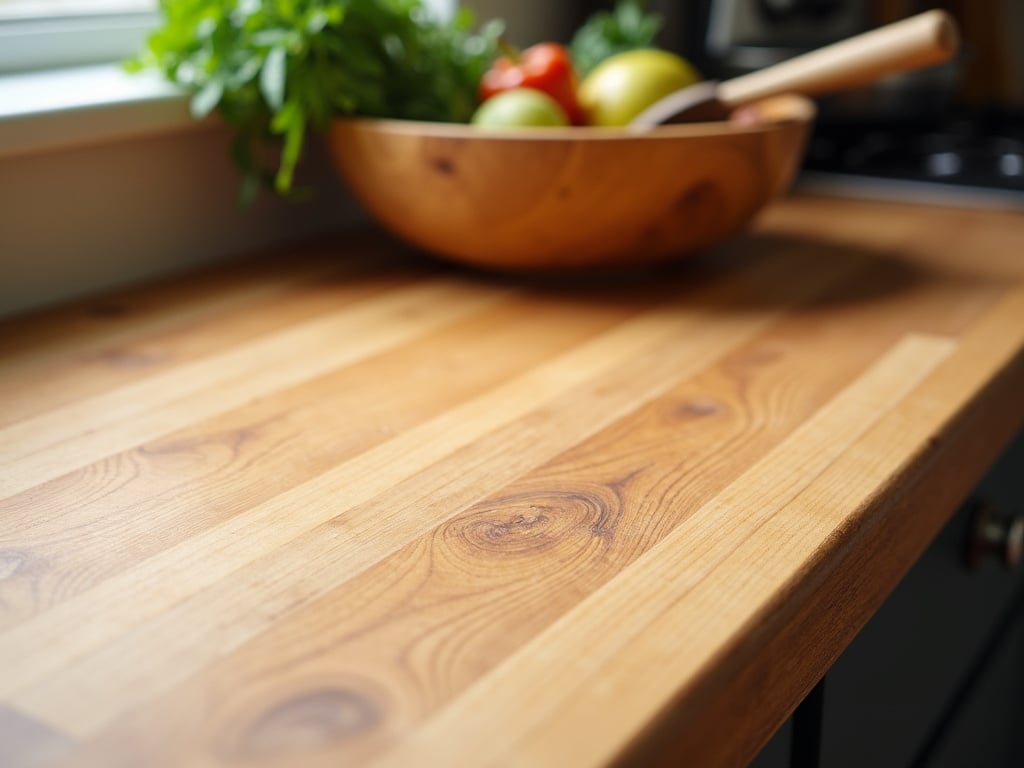
There’s something magical about stepping into a farmhouse kitchen that feels like a warm embrace. These cherished spaces have captured hearts for generations by blending rustic charm with modern functionality. They transport us to simpler times, evoking memories of family gatherings and the comforting aroma of home-cooked meals. But achieving that perfect balance of old-world charm and contemporary living can feel overwhelming. Where do you begin when dreaming of your own farmhouse haven?
Fear not! I’ve curated 22 timeless farmhouse kitchen ideas to inspire your design journey, breaking down each element to help create a space that’s both beautiful and authentically yours. From iconic sinks to subtle hardware choices, let’s explore how to craft the farmhouse kitchen you’ve always envisioned.
The farmhouse sink, with its distinctive exposed front, stands as the cornerstone of authentic farmhouse kitchen ideas. But these sinks aren’t just about aesthetics – they’re powerhouse workstations designed for the realities of farm life. Originally created for handling large-scale tasks like washing produce and poultry, modern farmhouse sinks maintain that same practical spirit with deep basins perfect for tackling oversized pots and mountains of dishes.

When considering installation, opt for a double-bowl design to maximize functionality. This configuration lets you dedicate one basin to washing and another to rinsing – a simple yet brilliant time-saver for busy cooks. Remember that these substantial fixtures require specialized support. Your base cabinet must be specifically designed to handle both the sink’s considerable weight and its distinctive apron-front style.
Moving from the heart of cleanup to the very walls that embrace your kitchen, let’s explore how to add authentic farmhouse character through thoughtful wall treatments.
Nothing says farmhouse kitchen ideas quite like the distinctive charm of shiplap walls. These horizontal planks, originally used as weatherproof exterior siding, have found new life indoors where they add irresistible texture and historical authenticity. But does shiplap belong in a kitchen, where moisture and splashes are constant companions? The answer lies in its origins – these interlocking boards were designed to repel water, making them surprisingly well-suited for kitchen environments.
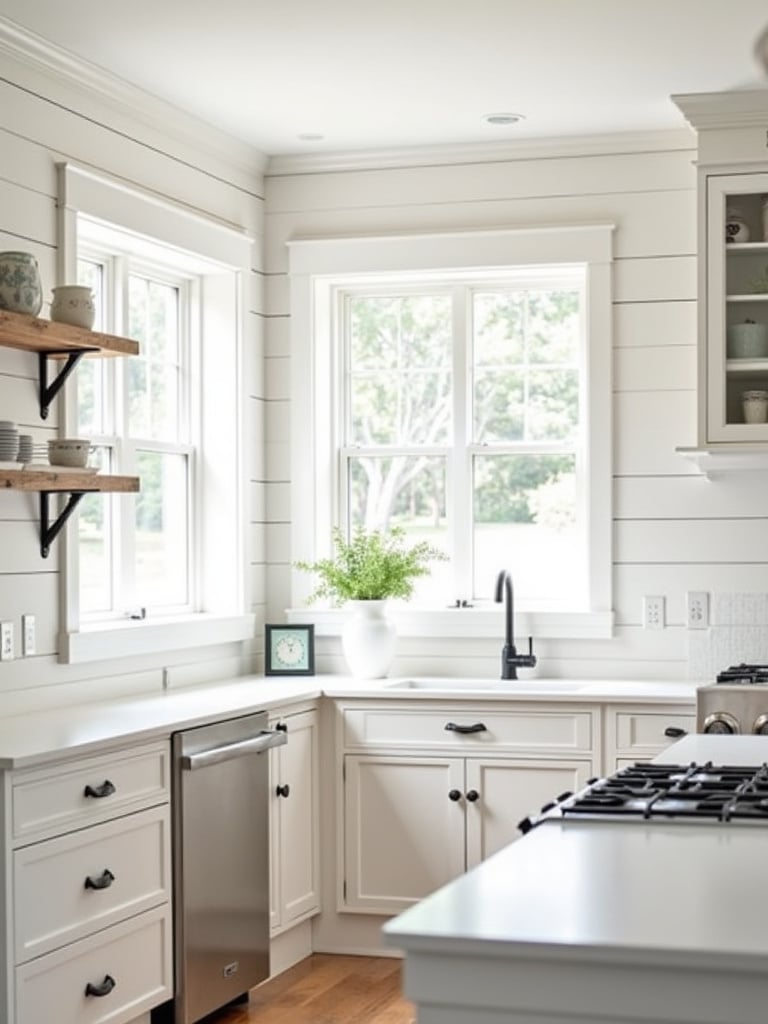
For a contemporary twist on this classic element, consider painting your shiplap in unexpected hues. While white remains popular, imagine the impact of soft grey or pale blue shiplap as an accent wall. The key to successful installation lies in precision: maintain consistent spacing between boards to achieve that coveted “nickel gap” look that defines authentic shiplap.
As we shift our focus from walls to storage solutions, let’s explore how open shelving can transform your farmhouse kitchen from merely functional to beautifully curated.
Among popular farmhouse kitchen ideas, open shelving offers a refreshing alternative to traditional upper cabinets. This storage approach harkens back to a time when kitchen items were kept within easy reach, turning everyday necessities into part of the room’s charm. But can open shelving work in today’s kitchens without creating visual chaos?
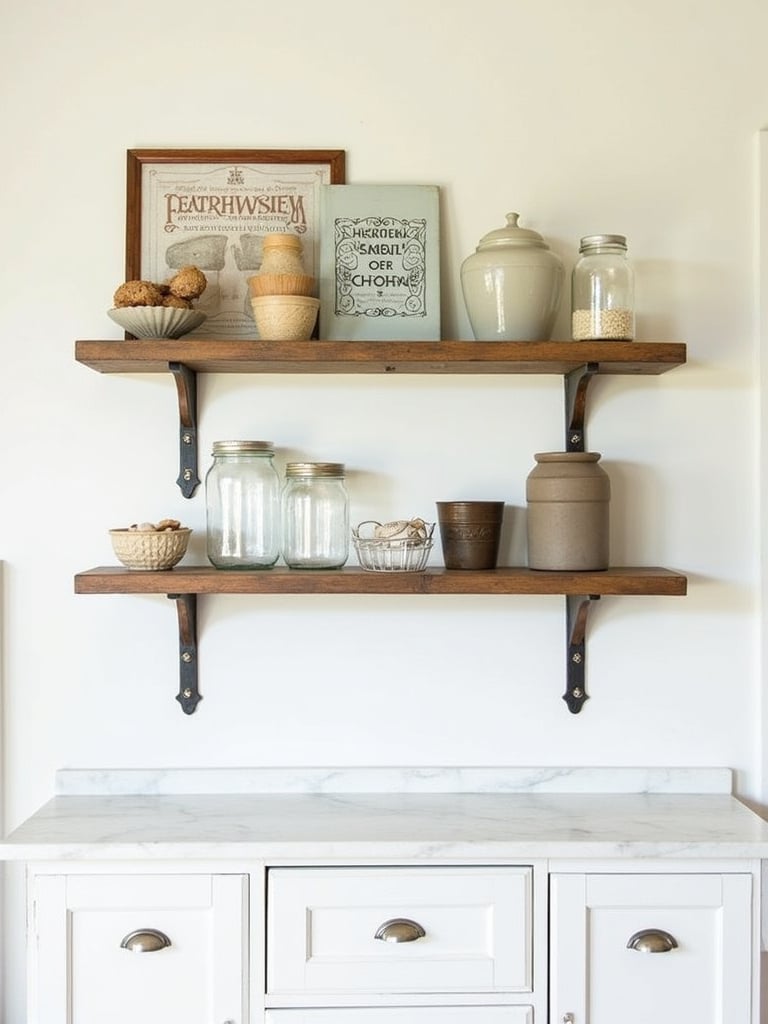
The secret lies in thoughtful curation and organization. Strike a balance by combining open shelves with closed cabinetry – showcase your prettiest pieces up top while keeping practical items tucked away below. Group similar items together, vary heights for visual interest, and don’t be afraid to leave some negative space. Consider displaying vintage crockery, mason jars filled with pantry staples, or beloved cookbooks to create an ever-changing gallery of kitchen treasures.
From displaying your cherished collections, let’s move to the workhorse surfaces that make your farmhouse kitchen both beautiful and functional – Butcher Block Countertops.
When exploring farmhouse kitchen ideas, butcher block countertops consistently emerge as a favorite for their ability to bring organic warmth to the space. These surfaces tell a story of craftsmanship, rooted in the tradition of butcher shops where durability and functionality reigned supreme. But can they stand up to the daily demands of a modern kitchen?

The key lies in strategic placement and proper maintenance. Consider installing butcher block on your kitchen island while using more moisture-resistant materials near the sink and stove. Regular care is simple but essential – a monthly application of food-grade mineral oil keeps the wood nourished and protected. Watch as your butcher block develops a rich patina over time, adding character that only comes with loving use.
As we move from work surfaces to gathering spaces, let’s explore how a farmhouse table can become the heart of your kitchen’s social life.
Among cherished farmhouse kitchen ideas, a sturdy table stands as perhaps the most significant symbol of home and family. These iconic pieces trace their roots to times when farm families and workers gathered for hearty meals, sharing stories and sustenance. Today’s farmhouse tables continue this tradition of bringing people together, though they’ve evolved to suit modern spaces and lifestyles.
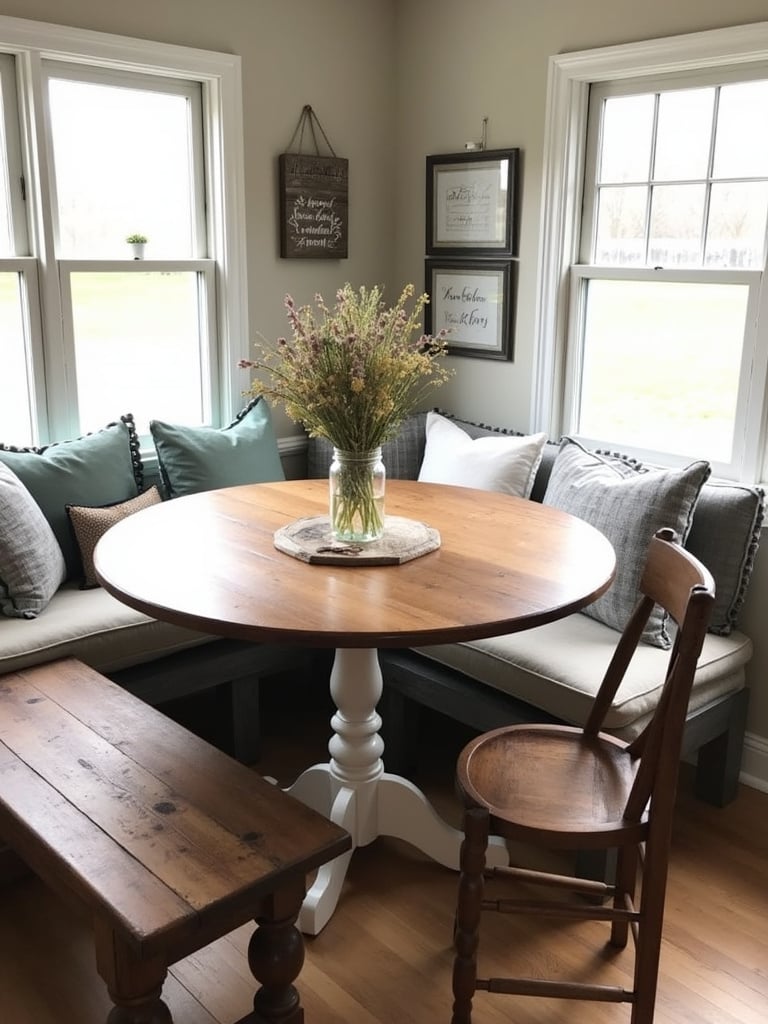
Don’t let limited space discourage you from incorporating this essential element. A round farmhouse table can work beautifully in smaller kitchens while maintaining that coveted rustic charm. Mix and match seating – perhaps combining a vintage bench with mismatched chairs – to create an collected-over-time feel that’s both casual and inviting. For styling, embrace simplicity: a mason jar filled with fresh wildflowers or a bowl of seasonal fruit provides the perfect finishing touch.
With our gathering space established, let’s illuminate your farmhouse kitchen with lighting that perfectly balances form and function.
Lighting plays a crucial role in executing farmhouse kitchen ideas, and pendant fixtures offer the perfect blend of task lighting and rustic style. Drawing inspiration from the utilitarian fixtures once found in barns and workshops, today’s farmhouse pendants marry historical charm with modern functionality. But how do you ensure they provide enough illumination for serious cooking?
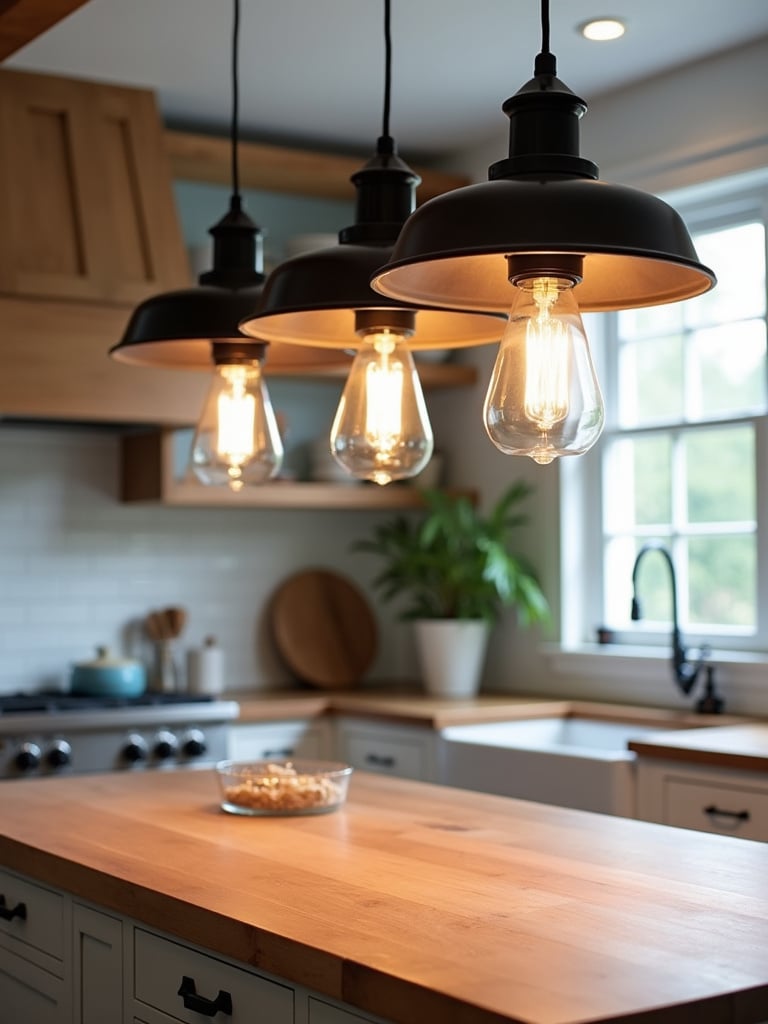
Success lies in thoughtful layering of light sources. Combine statement pendant lights over islands or dining areas with Recessed Lighting for ambient illumination and under-cabinet fixtures for task lighting. When hanging pendants, follow the golden rule: position them 30-36 inches above your work surface or table to provide optimal lighting without blocking sightlines or creating awkward shadows.
As we lift our eyes upward, let’s explore how exposed beams can add architectural interest and authentic character to your kitchen’s ceiling.
When implementing farmhouse kitchen ideas, few elements make as dramatic an impact as exposed ceiling beams. These architectural features speak to the very bones of traditional farm buildings, where structural elements were proudly displayed rather than hidden. But what if your home wasn’t blessed with original beams? Modern solutions offer surprisingly authentic alternatives.
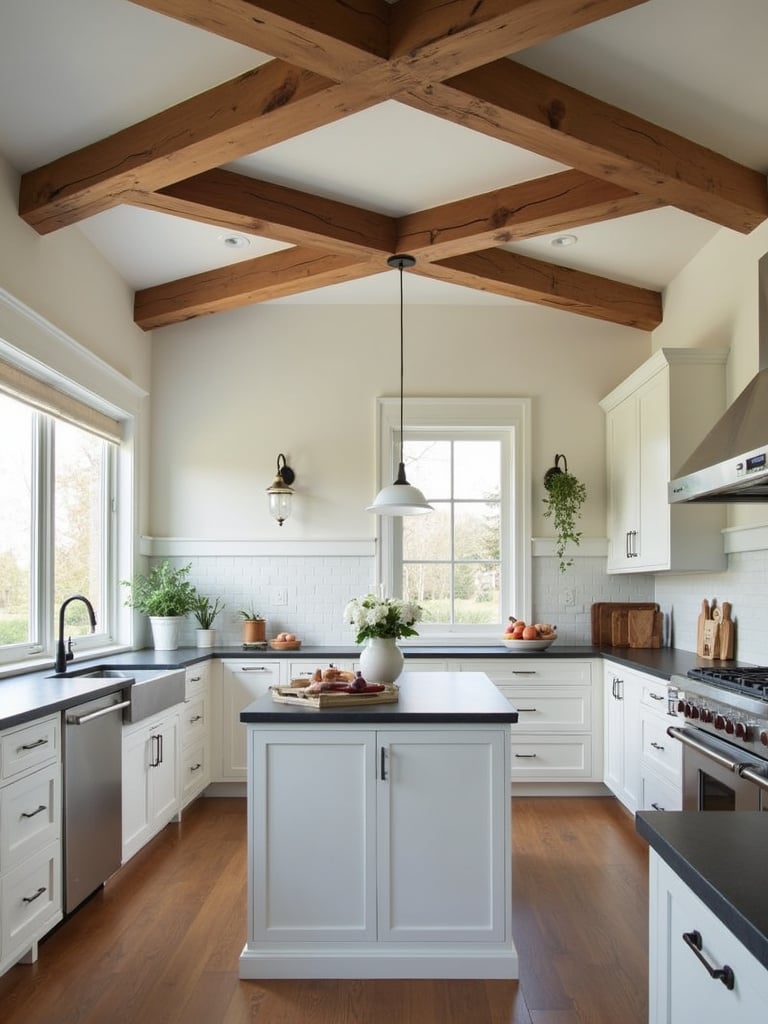
Today’s faux wood beams provide the visual impact of solid timber without the structural requirements or hefty price tag. Consider a whitewashed or soft grey finish to create a more contemporary farmhouse feel while maintaining that coveted architectural interest. The key is choosing a scale that complements your ceiling height – even modest rooms can benefit from thoughtfully sized beams that add character without overwhelming the space.
Let’s bring our attention back to ground level and explore one of the most foundational elements of farmhouse kitchen ideas – cabinetry that sets the perfect stage for your design.
White cabinets remain a cornerstone of farmhouse kitchen ideas, offering a bright, clean canvas that honors the style’s emphasis on light and airiness. This choice isn’t just about aesthetics – it reflects a historical appreciation for cleanliness and order in the kitchen. But how do you prevent an all-white kitchen from feeling sterile or one-dimensional?
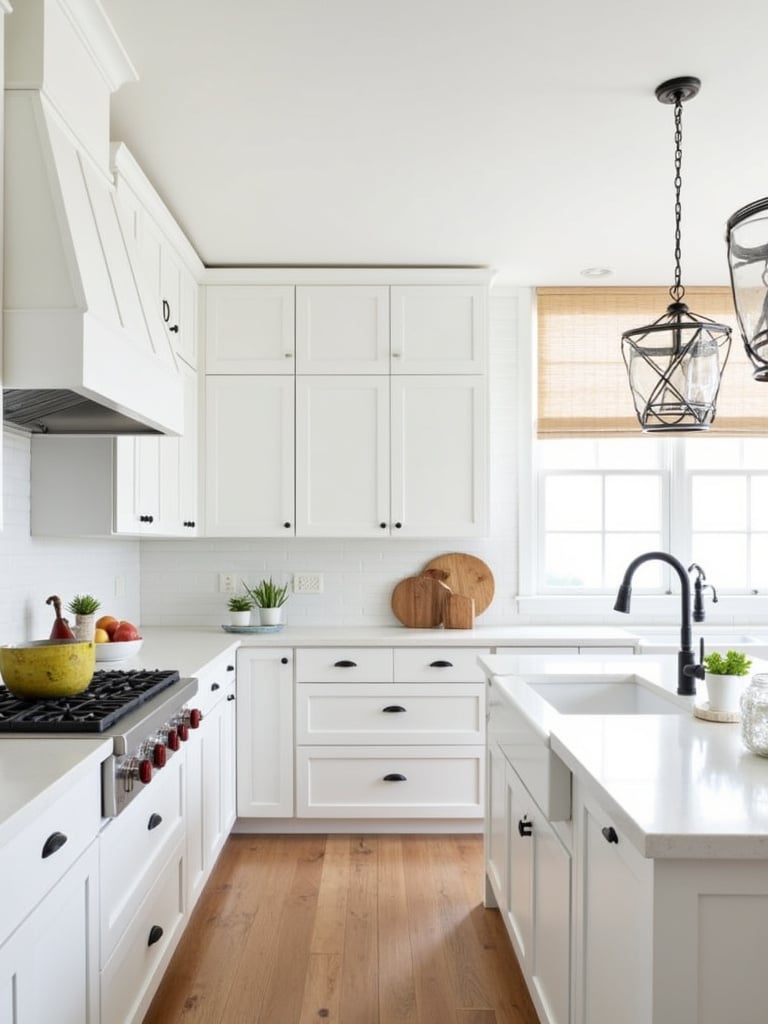
The secret lies in layering textures and subtle variations in white tones. Mix crisp Arctic white with warmer ivory or cream shades to create depth and interest. Incorporate beadboard details, raised panels, or glass-front upper cabinets to add visual texture. Consider pairing painted wood cabinets with natural wood elements to ground the space and maintain that essential farmhouse warmth.
From this pristine foundation, let’s explore how to build a color palette that creates the perfect atmosphere for your farmhouse kitchen.
Crafting the perfect neutral palette stands as one of the most important farmhouse kitchen ideas for establishing a calm, welcoming atmosphere. These soothing tones draw inspiration from natural materials – think weathered wood, aged stone, and natural linens. But how do you prevent a neutral kitchen from falling flat?

The magic happens through thoughtful layering and texture play. Start with a warm white or soft beige as your base, then build interest by incorporating various shades within your chosen neutral family. Mix materials freely: rough-hewn wood, smooth marble, woven textiles, and aged metals all contribute to a rich, nuanced environment. Remember, neutrals aren’t limited to beige and grey – soft, muted versions of colors found in nature can function as neutrals while adding subtle personality to your space.
While neutral tones form the backbone of many farmhouse kitchen ideas, thoughtful pops of color can breathe life into your space. Historical farmhouse kitchens weren’t afraid of color – from handmade quilts to pottery, bright hues have always played a role in creating a welcoming atmosphere. But how do you add color without overwhelming your carefully crafted farmhouse aesthetic?

The key lies in selective placement and choosing the right hues. Consider painting your island in a soft sage green or dusty blue, creating a focal point that anchors the room while maintaining its serenity. Alternatively, introduce color through easily changeable elements like bar stools, dish towels, or a collection of vintage enamelware. When selecting colors, look to nature for inspiration – muted blues, gentle greens, and warm terracotta all echo the countryside and complement traditional farmhouse elements beautifully.
From these fresh splashes of color, let’s explore how vintage elements can add soul and story to your space.
Among cherished farmhouse kitchen ideas, incorporating vintage pieces adds an authenticity that new items simply can’t replicate. These beloved artifacts carry stories of past generations, lending depth and character to your space. But how do you incorporate vintage elements without creating a kitchen that feels like a cluttered antique shop?

Success lies in selective curation and thoughtful placement. Choose pieces that serve a purpose while adding visual interest – perhaps an antique scale that doubles as art, or a collection of vintage canisters that provide beautiful storage. Mix old and new elements freely; the contrast between a modern appliance and a vintage bread box creates engaging visual tension. Display your finds in small, curated groupings rather than spreading them throughout the space, allowing each piece room to breathe and tell its story.
Now let’s turn our attention to the small but mighty details that can elevate your entire design – hardware choices that make a lasting impression.
When exploring farmhouse kitchen ideas, hardware might seem like a minor detail, but these small elements can significantly impact your overall design. Drawing inspiration from the practical, hardworking fixtures of traditional barns and workshops, farmhouse hardware combines durability with simple elegance. But how do you choose pieces that enhance your design without feeling too themed?

Focus on finishes and forms that complement your overall aesthetic while maintaining functionality. Oil-rubbed bronze and matte black hardware offer timeless appeal and pair beautifully with various design elements. Consider mixing classic bin pulls on drawers with simple knobs on upper cabinets for visual interest. The key is choosing pieces that feel substantial and authentic – look for hardware with weight and presence that backs up its appearance with genuine quality.
In the world of farmhouse kitchen ideas, few elements are as versatile and charming as mason jars. Since their invention in 1858, these practical vessels have evolved from simple canning containers to become iconic symbols of farmhouse style. But can such a simple storage solution really make a meaningful impact on your kitchen’s organization and aesthetics?
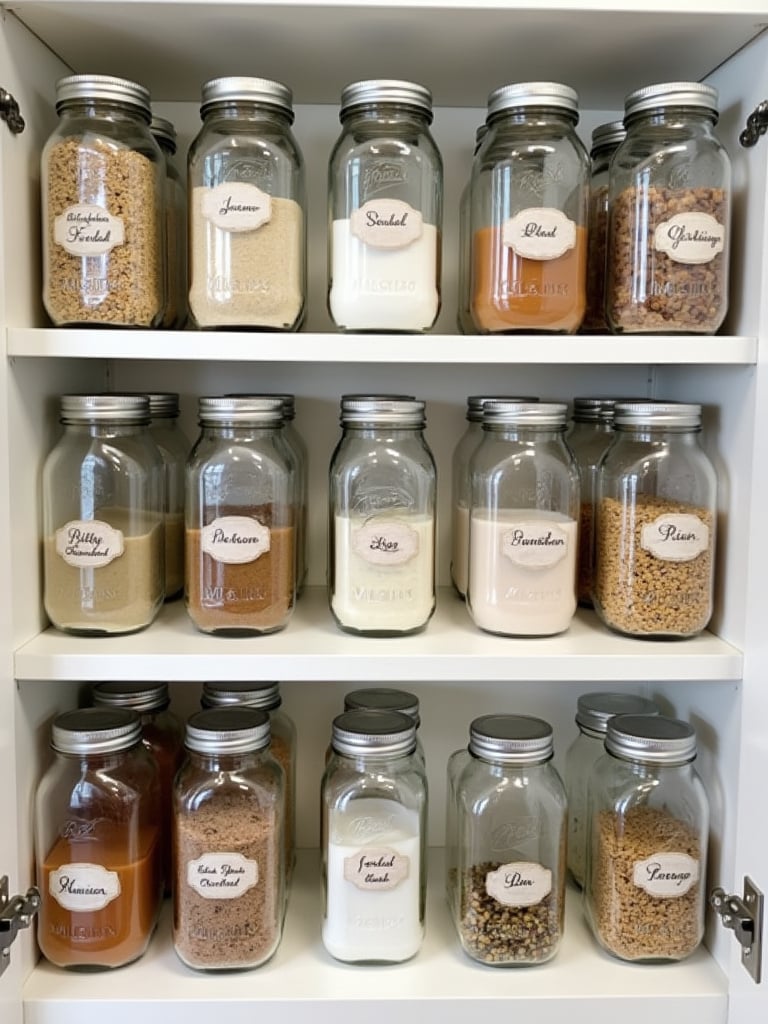
The beauty of mason jars lies in their versatility and visual appeal. Create an organized pantry display by using various jar sizes to store dry goods, with larger jars for pasta and grains, and smaller ones for spices and tea. Clear labeling becomes both functional and decorative – consider using chalk paint labels or vintage-style tags to maintain the farmhouse aesthetic. Group jars by contents and size to create visually pleasing arrangements that make cooking more efficient and enjoyable.
Let’s move our focus downward to explore flooring options that ground your farmhouse kitchen in warmth and character.
Among essential farmhouse kitchen ideas, wide plank wood flooring brings unmatched warmth and authenticity to your space. These generous boards harken back to early American homes, when wider planks were common simply because larger trees were readily available. But can such a traditional choice stand up to the demands of a modern kitchen?
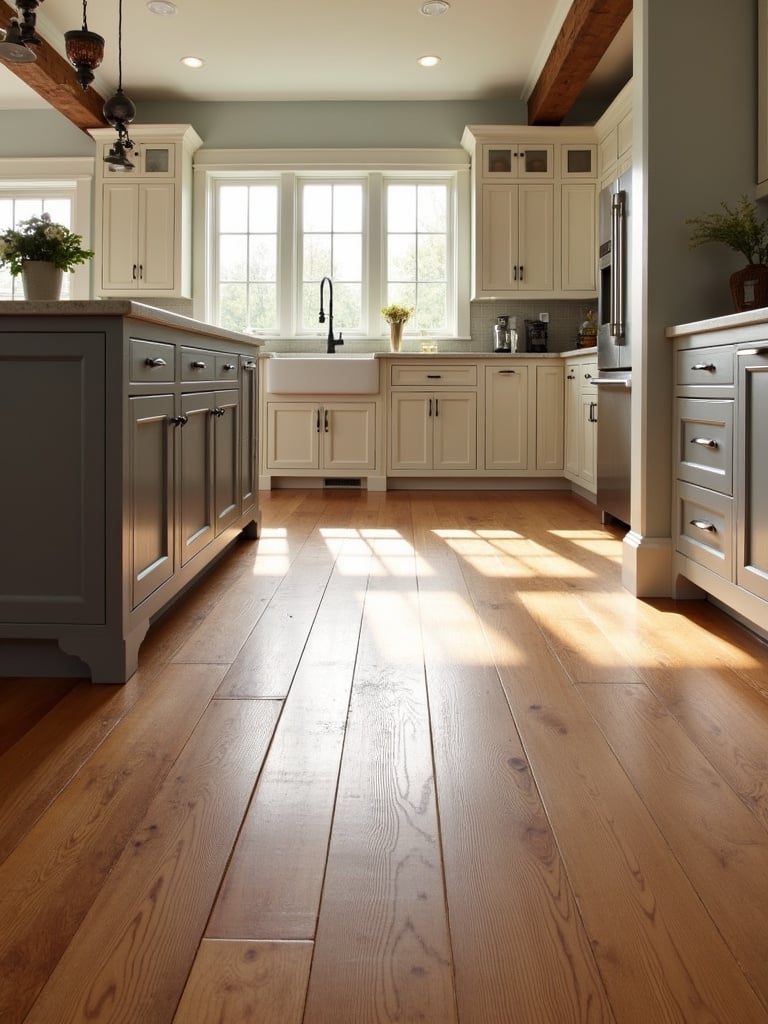
Today’s engineered wide plank flooring offers the best of both worlds – authentic appearance with improved durability. Choose boards engineered specifically for kitchen environments, offering enhanced moisture resistance while maintaining that coveted rustic appearance. A professional-grade polyurethane finish provides protection against water, scratches, and daily wear without compromising the wood’s natural beauty. The result? Flooring that grows more characterful with age, telling the story of your family’s life in the heart of your home.
From solid ground beneath our feet, let’s explore another natural element that adds both function and beauty – the versatile charm of woven baskets.
When implementing farmhouse kitchen ideas, woven baskets offer a perfect blend of form and function. These timeless storage solutions have served households for centuries, valued for their durability and handcrafted appeal. But how do you incorporate them in a way that feels both practical and aesthetically pleasing?
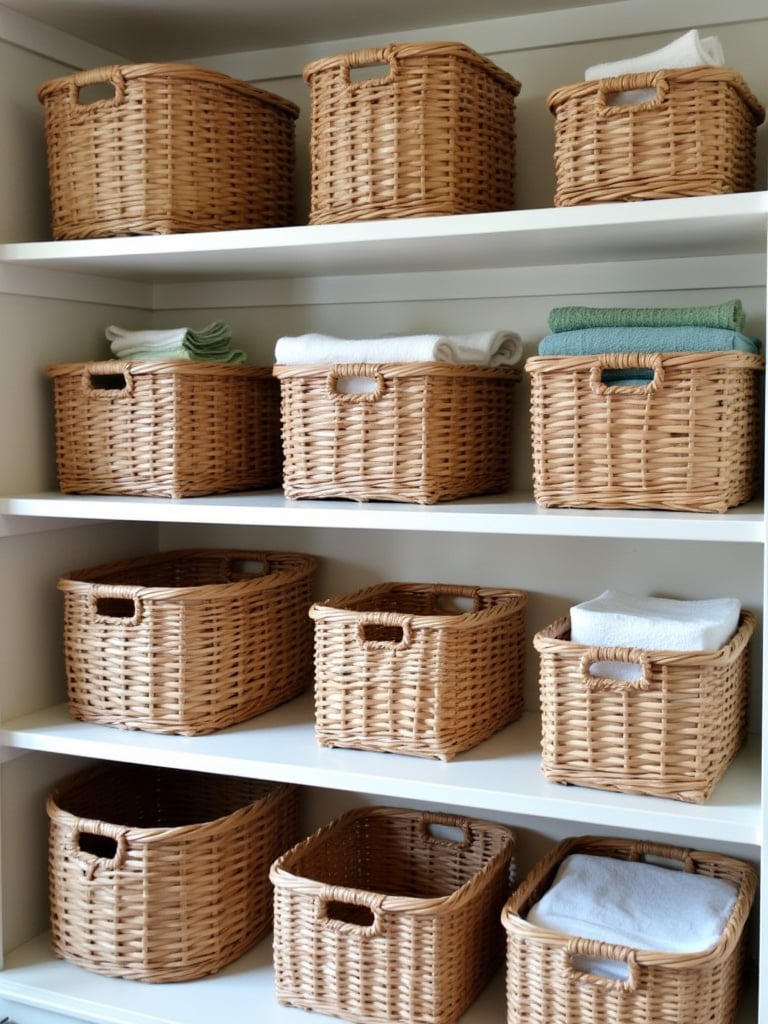
The secret lies in choosing the right baskets for specific storage needs while maintaining a cohesive look. Select natural materials like seagrass, rattan, or water hyacinth in similar tones to create visual harmony. Use larger baskets for storing bulky items like potatoes and onions, medium sizes for linens and dish towels, and smaller ones for organizing pantry items. Consider adding lined baskets for items that need extra protection, ensuring both beauty and practicality.
Among the most refreshing farmhouse kitchen ideas is the incorporation of living plants and fresh greenery. This tradition of bringing the outdoors in dates back generations, when herb gardens provided both seasoning and natural air freshening. But in today’s busy world, is maintaining kitchen plants practical, or will they become just another task on your to-do list?
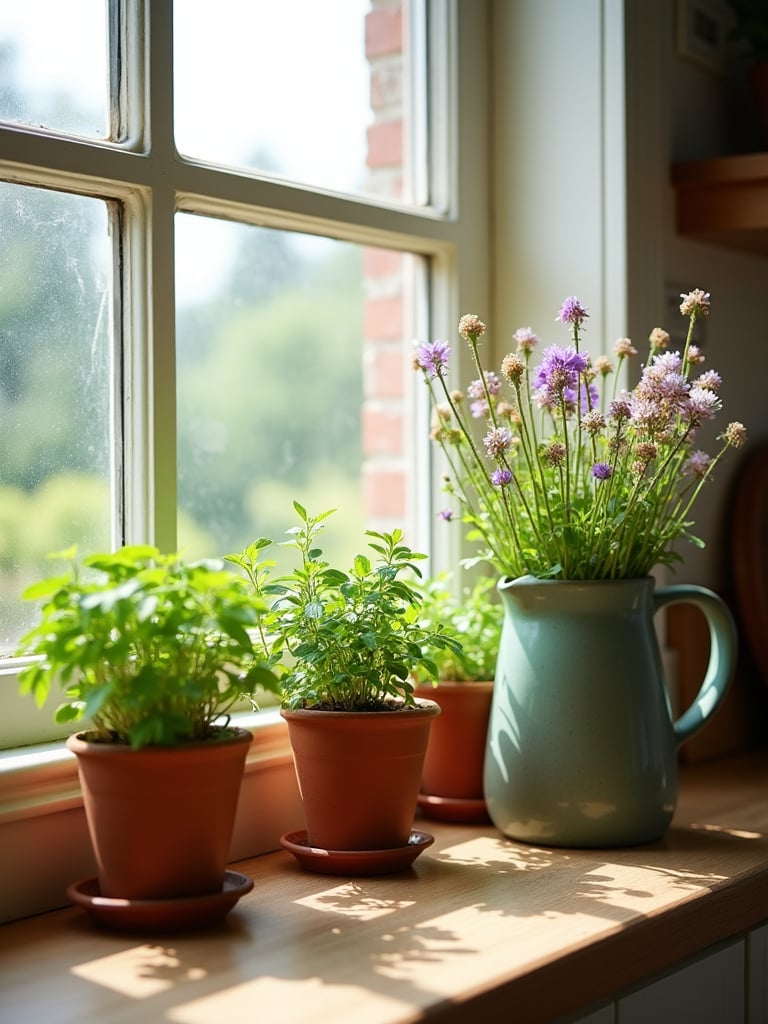
The key lies in choosing the right plants for your space and lifestyle. Create a practical herb garden on your windowsill with low-maintenance options like rosemary, basil, and thyme. These culinary workhorses not only add life to your space but also provide fresh flavors for your cooking. For seasonal beauty without the commitment, rotate cut flowers or branches in simple vessels – mason jars, vintage pitchers, or weathered crocks all make perfect farmhouse-style vases.
From living greenery, let’s turn our attention to one of the most enduring and versatile elements in farmhouse design – the classic subway tile backsplash.
When exploring farmhouse kitchen ideas, subway tile emerges as a classic choice that’s anything but ordinary. Born in New York City’s subway stations of the early 1900s, these simple rectangular tiles were chosen for their durability and easy-to-clean surface. But how do you make such a common element feel fresh and personal in your farmhouse kitchen?

The beauty of subway tile lies in its versatility and potential for creative installation. Break away from traditional horizontal patterns by experimenting with herringbone or vertical arrangements. Consider slightly irregular handmade-style tiles that add subtle texture and character, or explore different grout colors to enhance the pattern. The key is balancing timeless appeal with personal expression through thoughtful design choices.
Let’s shift our focus to a bold design choice that can dramatically impact your farmhouse kitchen – the sophisticated interplay of black and white.
Among striking farmhouse kitchen ideas, a black and white color scheme offers timeless sophistication with modern impact. This classic combination has graced kitchens for generations, but today’s interpretations bring fresh energy to the traditional farmhouse aesthetic. How do you prevent this high-contrast palette from feeling too stark or contemporary?
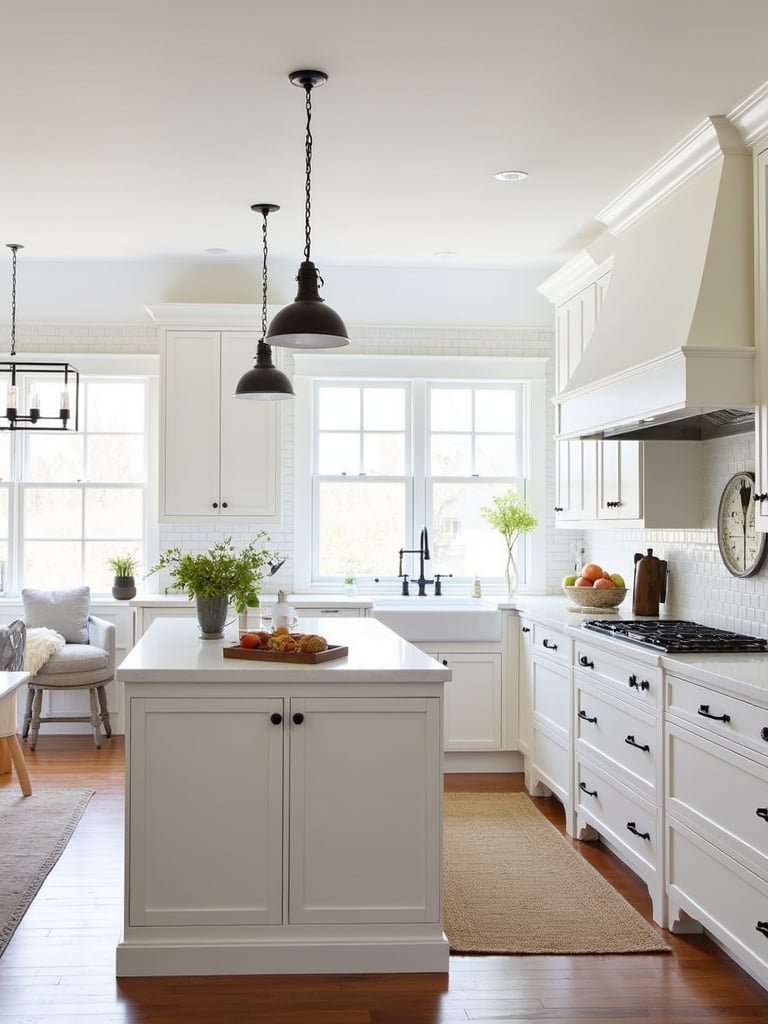
The secret lies in thoughtful balance and careful material selection. Incorporate natural elements like warm wood tones to soften the contrast – perhaps a butcher block island or exposed beams. Layer in textures through shiplap walls, textured tile, or vintage textiles to add depth and interest. Consider using black as an accent rather than a dominant color, allowing white to maintain the bright, airy feeling essential to farmhouse style.
A well-designed island stands central to modern farmhouse kitchen ideas, serving as both a functional workspace and social hub. This modern interpretation of the traditional farmhouse work table creates a gathering spot that connects your kitchen’s various zones. But what if your kitchen’s footprint seems too modest for such an addition?

Thankfully, islands can be scaled to suit any space. Consider a rolling cart for smaller kitchens – it provides the functionality of an island with added flexibility. For larger spaces, design your island with specific tasks in mind: perhaps a prep sink for washing vegetables, comfortable seating for casual meals, or extra storage for rarely-used items. The key is creating a multifunctional piece that serves your unique needs while maintaining that coveted farmhouse charm.
Let’s warm up our design with the rich, inviting glow of copper accents.
Among the most captivating farmhouse kitchen ideas is the incorporation of copper elements. This timeless metal has graced kitchens for centuries, prized not only for its beauty but also for its natural antimicrobial properties. But how do you incorporate copper without overwhelming your space or creating too much maintenance work?
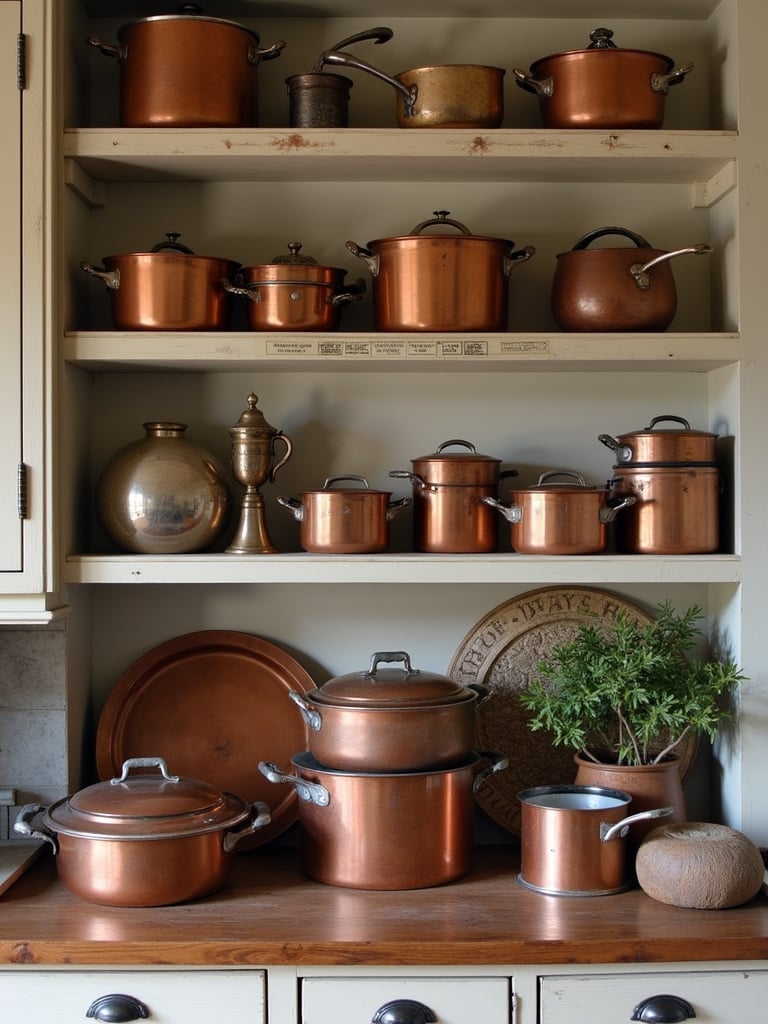
The secret lies in selective placement and embracing copper’s natural aging process. Use copper accents strategically – perhaps pendant lights above your island, a collection of copper cookware displayed on open shelving, or vintage copper molds as wall art. Don’t feel pressured to maintain a bright shine; copper’s developing patina tells a story of use and care, adding character to your space over time.
From metallic warmth to weathered wood, let’s explore how distressed furniture adds soul to your space.
When implementing farmhouse kitchen ideas, distressed furniture pieces add instant character and lived-in charm. These elements speak to the farmhouse tradition of making do and mending, where furniture earned its patina through years of faithful service. But how do you incorporate distressed pieces without making your kitchen look shabby rather than chic?

The key lies in selective use and thoughtful contrast. Choose one or two statement pieces – perhaps a vintage hutch for display or distressed bar stools at your island. Balance these weathered elements with crisp, clean-lined pieces to create appealing tension between old and new. Look for quality construction beneath the distressed finish; authentic wear tells a better story than artificial aging.
For our final design element, let’s look upward to a feature that combines both form and function in dramatic fashion.
Among standout farmhouse kitchen ideas, a statement range hood serves as both functional ventilation and architectural focal point. While modern versions may seem purely decorative, they honor the practical origins of farmhouse cooking where proper ventilation was essential. How do you choose a hood that makes the right statement without overwhelming your space?
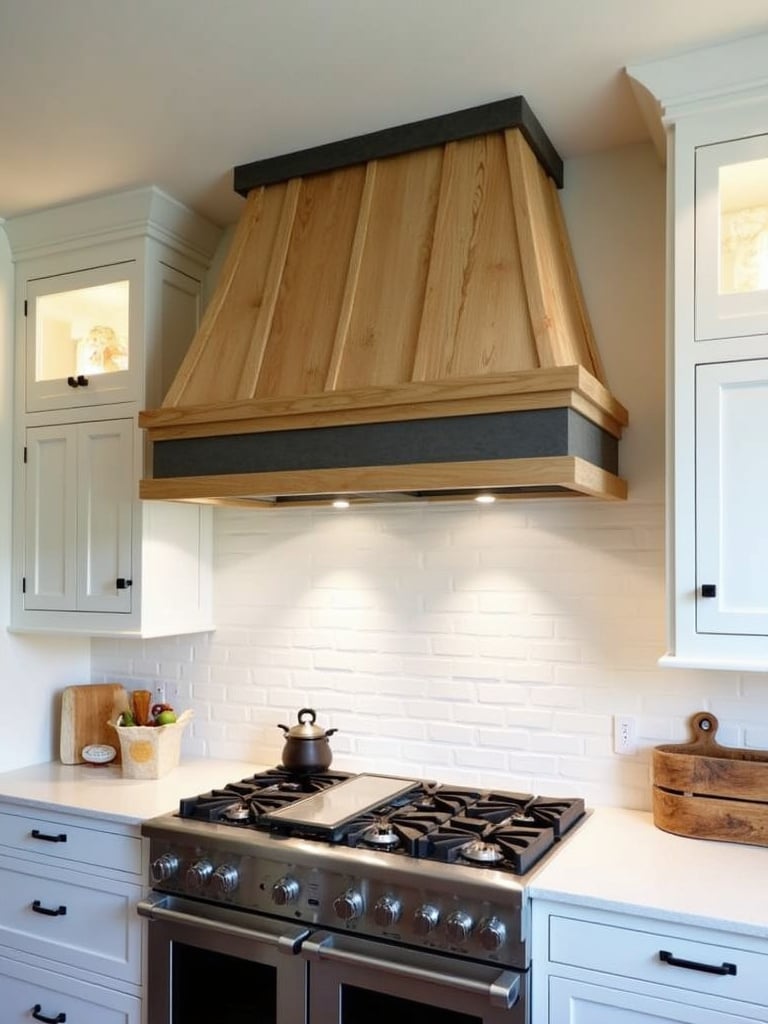
Success lies in proportional design and material selection. Scale your hood to complement both your range and ceiling height – dramatic without dominating. Consider materials that echo other elements in your kitchen: wooden trim to match exposed beams, metal banding that coordinates with hardware, or a painted finish that complements your cabinetry. This functional focal point should feel like a natural extension of your overall design rather than an afterthought.
Creating your ideal farmhouse kitchen isn’t about following a strict formula – it’s about thoughtfully combining elements that speak to both tradition and your personal style. These farmhouse kitchen ideas provide a framework for designing a space that’s not just beautiful, but truly functional and welcoming. From the practical charm of apron-front sinks to the warmth of copper accents, each element contributes to a kitchen that feels both timeless and personally yours.
Remember, the most successful farmhouse kitchens tell a story – your story. They combine old and new, practical and beautiful, classic and personal in a way that makes sense for your life. So take these ideas as inspiration, then trust your instincts to create a space where memories will be made for years to come. After all, the true heart of any farmhouse kitchen isn’t in its fixtures or finishes, but in the life and love that fill it every day.